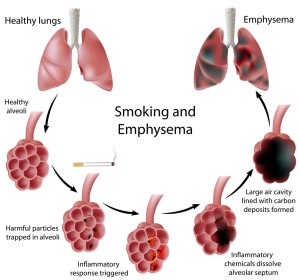Introduction
Emphysema is a pathological diagnosis and means when translated from the original Greek word “swelling of a body part”.
It is the alveoli(= air sacs) in the lungs that are swollen, which is where the air exchange takes place. Due to a loss of elastic tissue the air sacs melt into larger ones until eventually they form big balloon-like structures (called “bullae”).
This leads to breathing problems, particularly breathing the air out. With chronic lung disease the lungs have become stiff without the normal elasticity and the air gets trapped. Ephysema is part of the clinical picture of chronic obstructive pulmonary disease (COPD). Another condition, chronic bronchitis, is also part of the COPD complex, all of which is often found simultaneously in the same patient in different parts of the lungs. Occasionally severe end stage asthma can also lead to emphysema.
Emphysema Symptoms
The hallmark of emphysema is shortness of breath and a chronic cough. The term “pink puffer” has been coined to describe the usually pink skin colour due to open skin vessels (from carbon dioxide retention in the blood stream) and difficulties catching a breath. This site gives you a lot more information that may be of interest.
Diagnostic Tests
The testing is the same as for COPD. As emphysema is a chronic lung illness that requires a close follow-up and a lot of attention to detail, it is advisable to seek a referral from your general practitioner to a lung specialist (respirologist or pulmonologist). From the multitude of diagnostic tests the specialist will choose the ones that are most appropriate for a given patient.
Emphysema Treatment
For smokers this link, which shows the importance of quitting smoking (thanks to whyquit.com for this link) may convince them to follow through. Self hypnosis cassettes or discs can be very useful in assisting you to quit smoking.
There is a subgroup of patients with alpha-1 antitrypsin deficiency who get COPD because of an enzyme deficiency.
Otherwise the treatment for emphysema and COPD are identical.
References:
1. Noble: Textbook of Primary Care Medicine, 3rd ed., Copyright © 2001 Mosby, Inc.
2. National Asthma Education and Prevention Program. Expert Panel Report II. National Heart, Lung and Blood Institute, 1997.
3. Rakel: Conn’s Current Therapy 2002, 54th ed., Copyright © 2002 W. B. Saunders Company
4. Murray & Nadel: Textbook of Respiratory Medicine, 3rd ed., Copyright © 2000 W. B. Saunders Company
5. Behrman: Nelson Textbook of Pediatrics, 16th ed., Copyright © 2000 W. B. Saunders Company
6. Merck Manual: Emphysema (thanks to www.merckmanuals.com for this link)
7. Goldman: Cecil Textbook of Medicine, 21st ed., Copyright © 2000 W. B. Saunders Company
8. Ferri: Ferri’s Clinical Advisor: Instant Diagnosis and Treatment, 2004 ed., Copyright © 2004 Mosby, Inc.
9. Rakel: Conn’s Current Therapy 2004, 56th ed., Copyright © 2004 Elsevier







